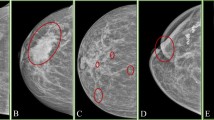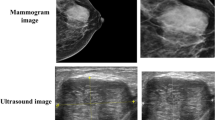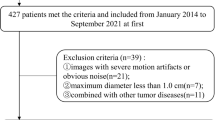Abstract
Purpose
A cost-sensitive extension of AdaBoost based on Markov random field (MRF) priors was developed to train an ensemble segmentation process which can avoid irregular shape, isolated points and holes, leading to lower error rate. The method was applied to breast tumor segmentation in ultrasonic images.
Methods
A cost function was introduced into the AdaBoost algorithm that penalizes dissimilar adjacent labels in MRF regularization. The extended AdaBoost algorithm generates a series of weak segmentation processes by sequentially selecting a process whose error rate weighted by the cost is minimum. The method was tested by generation of an ensemble segmentation process for breast tumors in ultrasonic images. This was followed by a active contour to refine the extracted tumor boundary.
Results
The segmentation performance was evaluated by tenfold cross validation test, where 300 carcinomas, 50 fibroadenomas, and 50 cysts were used. The experimental results revealed that the error rate of the proposed ensemble segmentation was two-thirds the error rate of the segmentation trained by AdaBoost without MRF. By combining the ensemble segmentation with a geodesic active contour, the average Jaccard index between the extracted tumors and the manually segmented true regions was 93.41%, significantly higher than the conventional segmentation process.
Conclusion
A cost-sensitive extension of AdaBoost based on MRF priors provides an efficient and accurate means for the segmentation of tumors in breast ultrasound images.
Similar content being viewed by others
References
Shankar PM, Reid JM, Ortega H, Piccoli CW, Goldberg BB (1993) Use of non-Rayleigh statistics for the identification of tumors in ultrasonic B-scans of the breast. IEEE Trans Med Imaging 12(4): 687–692
Garra BS, Krasner BH, Horii SC, Ascher S, Mun SK, Zeman RK (1993) Improving the distinction between benign and malignant breast lesions: the value of sonographic texture analysis. Ultrason Imaging 15(4): 267–285
Haralick RM, Shanmugam K, Dinstein I (1973) Textural features for image classification. IEEE Trans Syst Man Cybern SMC- 3(6): 610–621
Weng L, Reid JM, Shankar PM, Soetanto K (1991) Ultrasound speckle analysis based on K-distribution. J Acoust Soc Am 89(6): 2992–2995
Aleman-Flores M, Alvarez L, Caselles V (2007) Texture-oriented anisotropic filtering and geodesic active contours in breast tumor ultrasound segmentation. J Math Imaging 28: 81–97
Caselles V, Kimmel R, Sapiro G (1997) Geodesic active contour. Int J Comput Vision 22(1): 61–79
Shimizu A, Narihira T, Furukawa D, Kobatake H, Nawano S, Shinozaki K (2008) Ensemble segmentation using AdaBoost with application to liver lesion extraction from a CT volume. Proceedings of workshop in MICCAI2008
Niessen W, Walsum T, Schaap M et al (2008) 3D segmentation in the clinic: a grand challenge II. Proceedings of workshop in MICCAI2008, http://grand-challenge2008.bigr.nl/
Freund Y, Schapire RE (1997) A decision-theoretic generalization of on-line learning and an application to boosting. J Comput Syst Sci 55(1): 119–139
Besag J (1974) Spatial interaction and the statistical analysis of lattice systems. J Royal Statist Soc B 36(2): 192–236
Besag J (1986) On the statistical analysis of dirty pictures. J Royal Statist Soc B 48(3): 259–302
Perez P (1998) Markov random fields and images. CWI-Quarterly 11(4): 413–437
Masnadi-Shirazi H, Vasconcelos N (2007) Asymmetric boosting. Proceedings of the 24th international conference on machine learning, pp 609–619
Stan Z Li (2001) Markov random field modeling in image analysis. Springer, Berlin
Nishii R, Eguchi S (2005) Supervised image classification by contextual AdaBoost based on posteriors in neighborhoods. IEEE Trans Geosci Remote Sens 43(11): 2547–2554
Takemura A, Shimizu A, Hamamoto K (2010) Discrimination of breast tumors in ultrasonic images using an ensemble classifier based on the AdaBoost algorithm with feature selection. IEEE Trans Med Imaging. 29(3): 598–609
Perona P, Malik L (1990) Scale-spacing and edge detection using anisotropic diffusion. IEEE Trans Pattern Anal Machine Intell 12: 629–639
Press WH, Teukolsky SA, Vettering WT, Flannery BP (2003) Numerical recipes in C. Cambridge University Press, Cambridge, pp 683–688
Ibanez L, Schroeder W, Ng L, Cates J. The ITK software guide, http://www.itk.org/, pp 550–555
Author information
Authors and Affiliations
Corresponding author
Rights and permissions
About this article
Cite this article
Takemura, A., Shimizu, A. & Hamamoto, K. A cost-sensitive extension of AdaBoost with markov random field priors for automated segmentation of breast tumors in ultrasonic images. Int J CARS 5, 537–547 (2010). https://doi.org/10.1007/s11548-010-0411-1
Received:
Accepted:
Published:
Issue Date:
DOI: https://doi.org/10.1007/s11548-010-0411-1




